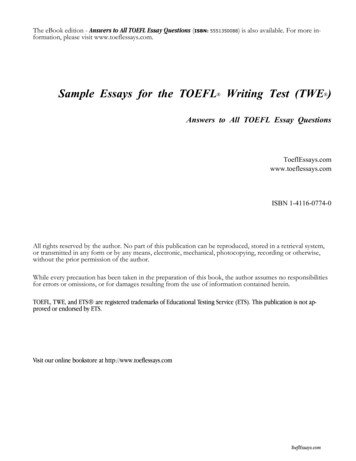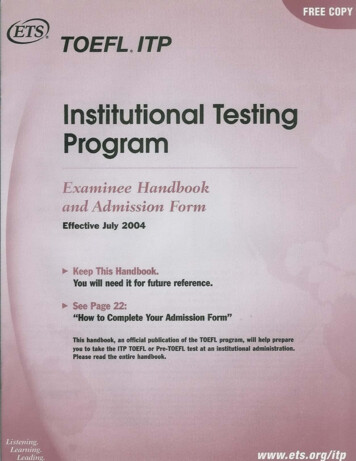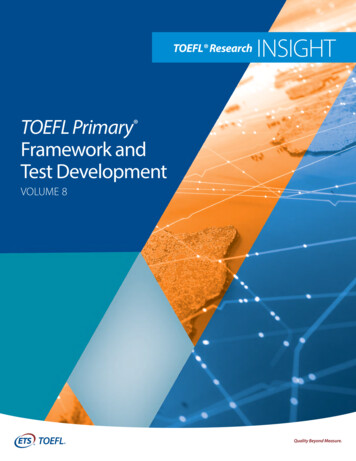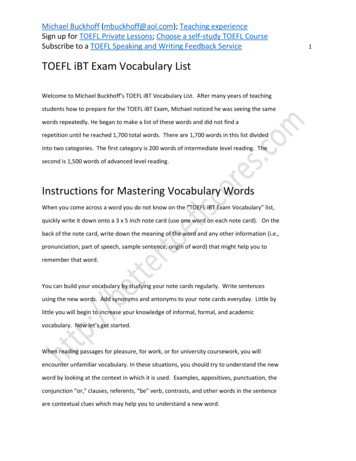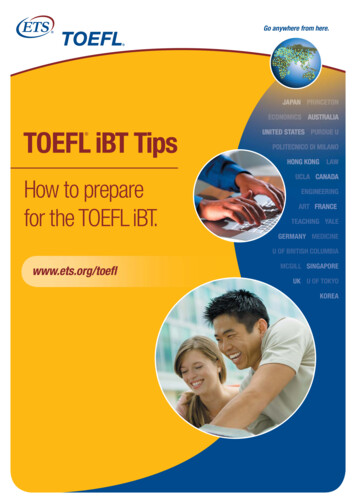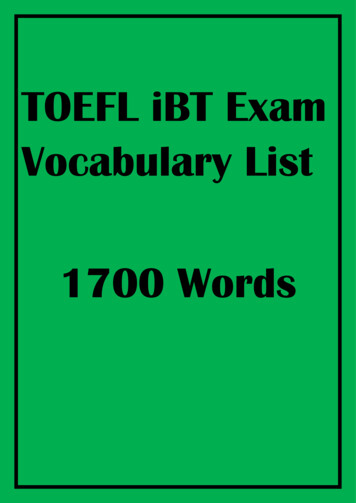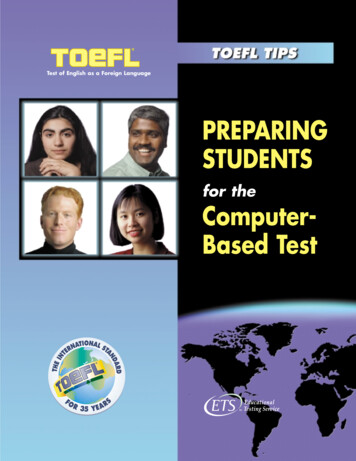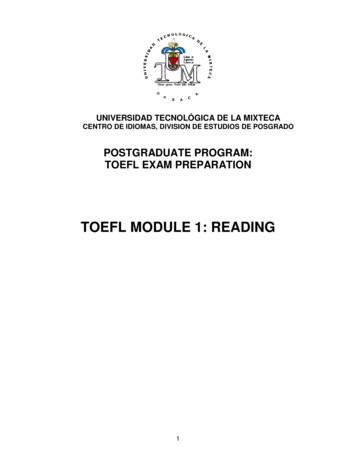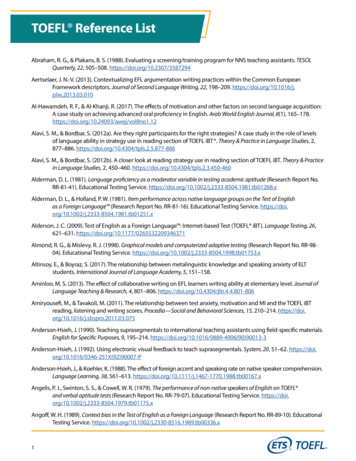
Transcription
TOEFL Reference ListAbraham, R. G., & Plakans, B. S. (1988). Evaluating a screening/training program for NNS teaching assistants. TESOLQuarterly, 22, 505–508. https://doi.org/10.2307/3587294Aertselaer, J. N.-V. (2013). Contextualizing EFL argumentation writing practices within the Common EuropeanFramework descriptors. Journal of Second Language Writing, 22, 198–209. deh, R. F., & Al-Khanji, R. (2017). The effects of motivation and other factors on second language acquisition:A case study on achieving advanced oral proficiency in English. Arab World English Journal, 8(1), Alavi, S. M., & Bordbar, S. (2012a). Are they right participants for the right strategies? A case study in the role of levelsof language ability in strategy use in reading section of TOEFL iBT . Theory & Practice in Language Studies, 2,877–886. https://doi.org/10.4304/tpls.2.5.877-886Alavi, S. M., & Bordbar, S. (2012b). A closer look at reading strategy use in reading section of TOEFL iBT. Theory & Practicein Language Studies, 2, 450–460. https://doi.org/10.4304/tpls.2.3.450-460Alderman, D. L. (1981). Language proficiency as a moderator variable in testing academic aptitude (Research Report No.RR-81-41). Educational Testing Service. Alderman, D. L., & Holland, P. W. (1981). Item performance across native language groups on the Test of Englishas a Foreign Language (Research Report No. RR-81-16). Educational Testing Service. Alderson, J. C. (2009). Test of English as a Foreign Language : Internet-based Test (TOEFL iBT). Language Testing, 26,621–631. https://doi.org/10.1177/0265532209346371Almond, R. G., & Mislevy, R. J. (1998). Graphical models and computerized adaptive testing (Research Report No. RR-9804). Educational Testing Service. Altinsoy, E., & Boyraz, S. (2017). The relationship between metalinguistic knowledge and speaking anxiety of ELTstudents. International Journal of Language Academy, 5, 151–158.Aminloo, M. S. (2013). The effect of collaborative writing on EFL learners writing ability at elementary level. Journal ofLanguage Teaching & Research, 4, 801–806. i, M., & Tavakoli, M. (2011). The relationship between test anxiety, motivation and MI and the TOEFL iBTreading, listening and writing scores. Procedia—Social and Behavioral Sciences, 15, 210–214. on-Hsieh, J. (1990). Teaching suprasegmentals to international teaching assistants using field-specific materials.English for Specific Purposes, 9, 195–214. on-Hsieh, J. (1992). Using electronic visual feedback to teach suprasegmentals. System, 20, 51–62. on‐Hsieh, J., & Koehler, K. (1988). The effect of foreign accent and speaking rate on native speaker comprehension.Language Learning, 38, 561–613. Angelis, P. J., Swinton, S. S., & Cowell, W. R. (1979). The performance of non-native speakers of English on TOEFL and verbal aptitude tests (Research Report No. RR-79-07). Educational Testing Service. Angoff, W. H. (1989). Context bias in the Test of English as a Foreign Language (Research Report No. RR-89-10). EducationalTesting Service. 1
TOEFL Reference ListArshavskaya, E. (2015). International Teaching Assistants’ Experiences in the U.S. Classrooms: Implications for Practice.Journal of the Scholarship of Teaching and Learning, 15(2), 56–69. kaya, E. (2016). Using reflective dialogic blogs with international teaching assistants: Rationale, context, andfindings. Writing & Pedagogy, 8, 333–359.Asmani, A. B. (2014). Correlative analysis of TOEFL iBT scores of listening skill versus scores of Business English speakingskill among Binus University sophomores. Lingua Cultura, 8, 85–94. https://doi.org/10.21512/lc.v8i2.447Attali, Y. (2007). Construct validity of e-rater in scoring TOEFL essays (Research Report No. RR-07-21). Educational TestingService. Attali, Y. (2011). Automated subscores for TOEFL iBT independent essays (Research Report No. RR-11-39). EducationalTesting Service. Attali, Y., Bridgeman, B., & Trapani, C. (2010). Performance of a generic approach in automated essay scoring. TheJournal of Technology, Learning, and Assessment, 10(3), 1–6.Attali, Y., Powers, D. E., Tannenbaum, R. J., Wylie, E. C., Kim, S., Walker, M. E., . . . Briller, V. (2009). In D. Eignor (Ed.), ETSResearch Spotlight. Retrieved from dfAttali, Y., & Sinharay, S. (2015). Automated trait scores for TOEFL writing tasks (Research Report No. RR-15-14). EducationalTesting Service. https://doi.org/10.1002/ets2.12061Babenko, T. (2013). Speaking and writing strategies for TOEFL iBT. TESOL Journal, 4(1), 194–196. https://doi.org/10.1002/tesj.70Bailey, K. M. (1999). Washback in language testing (Research Memorandum No. RM-99-04). Educational Testing Service.Banerjee, J., & Clapham, C. (2003). Test review: The TOEFL CBT (Computer-based test). Language Testing, 20, xBanzina, E., Hewitt, L. E., & Dilley, L. C. (2014). Using synchronous speech to facilitate acquisition of English rhythm:A small scale study. EuroAmerican Journal of Applied Linguistics and Languages, 1(1), 69–84. http://dx.doi.org/10.21283/2376905X.1.9Barkaoui, K. (2014). Examining the impact of L2 proficiency and keyboarding skills on scores on TOEFL iBT writing tasks.Language Testing, 31, 241–259. https://doi.org/10.1177/0265532213509810Barkaoui, K. (2015). Test takers’ writing activities during the TOEFL iBT writing tasks: A stimulated recall study (ResearchReport No. RR-15-04). Princeton, NJ: Educational Testing Service. https://doi.org/10.1002/ets2.12050Barkaoui, K. (2016). What and when second-language learners revise when responding to timed writing tasks on thecomputer: The roles of task type, second language proficiency, and keyboarding skills. Modern LanguageJournal, 100, 320–340. https://doi.org/10.1111/modl.12316Barkaoui, K., Brooks, L., Swain, M., & Lapkin, S. (2013). Test-takers’ strategic behaviors in independent and integratedspeaking tasks. Applied Linguistics, 34, 304–324. https://doi.org/10.1093/applin/ams046Barkaoui, K. & Hadidi, A. (2021). Assessing changes in second Language writing performance. Routledge. adidi/p/book/9780367551902Barnes, M. (2016). The washback of the TOEFL iBT in Vietnam. Australian Journal of Teacher Education, 41(7), 102
TOEFL Reference ListBarnes, M. (2017). Washback: Exploring what constitutes “good” teaching practices. Journal of English for AcademicPurposes, 30, 1–12. https://doi.org/10.1016/j.jeap.2017.10.003Baron, P. A., & Papageorgiou, S. (2014). Mapping the TOEFL Primary Test onto the Common European Framework ofReference (Research Memorandum No. RM-14-05). Educational Testing Service.Baron, P. A., & Papageorgiou, S. (2016). Setting language proficiency score requirements for English-as-a-second-languageplacement decisions in secondary education (Research Report No. RR-16-17). Educational Testing Service.https://doi.org/10.1002/ets2.12102Baron, P. A., & Tannenbaum, R. J. (2011). Mapping the TOEFL Junior test onto the Common European Framework ofReference (Research Memorandum No. RM-11-07). Educational Testing Service.Beardsmore, H. B., & Renkin, A. (1971). Test of spoken English . IRAL: International Review of Applied Linguistics inLanguage Teaching, 9, 1–11. https://doi.org/10.1515/iral.1971.9.1.1Bejar, I. I. (1985a). A preliminary study of raters for the Test of Spoken EnglishTM (Research Report No. RR-85-05).Educational Testing Service. Bejar, I. I. (1985b). Test speededness under number-right scoring: An analysis of the Test of English as a Foreign Language(Research Report No. RR-85-11). Educational Testing Service. Bejar, I., Douglas, D., Jamieson, J., Nissan, S., & Turner, J. (2000). TOEFL 2000 listening framework: A working paper(Research Memorandum No. RM-00-07). Educational Testing Service.Ben-David, M. F., Klass, D. J., Boulet, J., Champlain, A. D., King, A. M., Pohl, H. S., & Gary, N. C. (1999). The performanceof foreign medical graduates on the National Board of Medical Examiners (NBME) standardized patientexamination prototype: A collaborative study of the NBME and the educational Commission for ForeignMedical Graduates (ECFMG). Medical Education, 33, 439–446. at, S., & Yoon, S.-Y. (2015). Automatic assessment of syntactic complexity for spontaneous speech scoring. SpeechCommunication, 67, 42–57. https://doi.org/10.1016/j.specom.2014.09.005Biber, D. (2003). Variation among university spoken and written registers: A new multi-dimensional analysis. In C.Meyer & P. Leistyna (Eds.), Corpus analysis: Language structure and language use (pp. 47–70). Rodopi.Biber, D. (2006a). Stance in spoken and written university registers. Journal of English for Academic Purposes, 5, 1Biber, D. (2006b). University language: A corpus-based study of spoken and written registers. Benjamins.Biber, D., & Barbieri, F. (2007). Lexical bundles in university spoken and written registers. English for Specific Purposes, 26,263–286. https://doi.org/10.1016/j.esp.2006.08.003Biber, D., Conrad, S., & Cortes, V. (2004). If you look at : Lexical bundles in university teaching and textbooks. AppliedLinguistics, 25, 371–405. https://doi.org/10.1093/applin/25.3.371Biber, D., Conrad, S., Reppen, R., Byrd, P., & Helt, M. (2002). Speaking and writing in the university: A multi-dimensionalcomparison. TESOL Quarterly, 36, 9–48. https://doi.org/10.2307/3588359Biber, D., Conrad, S. M., Reppen, R., Byrd, P., Helt, M., Clark, V., . . . Urzua, A. (2004). Representing language use in theuniversity: Analysis of the TOEFL 2000 spoken and written academic language corpus (Research MemorandumNo. RM-04-03). Educational Testing Service.3
TOEFL Reference ListBiber, D., Csomay, E., Jones, J. K., & Keck, C. (2004a). A corpus linguistic investigation of vocabulary-based discourseunits in university registers. In U. Connor & T. A. Upton (Eds.), Applied corpus linguistics: A multi-dimensionalperspective (pp. 53–72). Rodopi.Biber, D., Csomay, E., Jones, J. K., & Keck, C. (2004b). Vocabulary-based discourse units in university registers. In A.Partington, J. Morley, & L. Haarman (Eds.), Corpora and discourse (pp. 23–40). Peter Lang.Biber, D., & Gray, B. (2013). Discourse characteristics of writing and speaking task types on the TOEFL iBT test: Alexico-grammatical analysis (Research Report No. RR-13-04). Educational Testing Service. Biber, D., Gray, B., & Staples, S. (2016). Predicting patterns of grammatical complexity across language exam: Task typesand proficiency levels. Applied Linguistics, 37, 639–668. https://doi.org/10.1093/applin/amu059Biber, D., Nekrasova, T., & Horn, B. (2011). The effectiveness of feedback for L1-English and L2-writing development:A meta-analysis (Research Report No. RR-11-05). Educational Testing Service. Biber, D., Reppen, R., & Staples, S. (2017). Exploring the relationship between TOEFL iBT scores and disciplinary writingperformance. TESOL Quarterly, 51, 948–960. https://doi.org/10.1002/tesq.359Boldt, R. F. (1988). Latent structure analysis of the Test of English as a Foreign Language (Research Report No. RR-88-27).Educational Testing Service. Boldt, R. F. (1991). Cross-validation of a proportional item response curve model (Research Report No. RR-91-33).Educational Testing Service. Boldt, R. F. (1992). Reliability of the Test of Spoken English revisited (Research Report No. RR-92-52). Educational TestingService. Boldt, R. F. (1994). Simulated equating using several item response curves (Research Report No. RR-93-57). EducationalTesting Service. Boldt, R. F., & Courtney, R. G. (1997). Survey of standards for foreign student applicants (Research Report No. RR-97-07).Educational Testing Service. Boldt, R. F., & Freedle, R. O. (1996). Using a neural net to predict item difficulty (Research Report No. RR-96-31).Educational Testing Service. Boldt, R. F., Larsen-Freeman, D., Reed, M. S., & Courtney, R. G. (1992). Distributions of ACTFL ratings by TOEFL scoreranges (Research Report No. RR-92-59). Educational Testing Service. Boldt, R. F., & Oltman, P. K. (1993). Multimethod construct validation of the Test of Spoken English (Research Report No. RR93-58). Educational Testing Service. Boraie, D., Arrigoni, E., & Moos, J. (2017). A survey of English language proficiency requirements for admission toEnglish-medium universities in Arabic-speaking countries. In A. Gebril (Ed.), Applied linguistics in the Middle Eastand North Africa (pp. 228–247). John Benjamins.Boyd, F. A. (1989). Developing presentation skills: A perspective derived from professional education. English for SpecificPurposes, 8, 195–203. d, H., & Lee, Y.-W. (2007). Investigating uniform and non-uniform gender DIF in computer-based ESL writingassessment. Applied Measurement in Education, 20, 377–403. https://doi.org/10.1080/089573407014296524
TOEFL Reference ListBreland, H., Lee, Y.-W., & Muraki, E. (2004a). Comparability of TOEFL CBT writing prompts: Response mode analyses(Research Report No. RR-04-23). Educational Testing Service. Breland, H., Lee, Y.-W., & Muraki, E. (2004b). Comparability of TOEFL CBT essay prompts: Responsenmode analyses.Educational and Psychological Measurement, 65, 577–595.Breland, H., Lee, Y.-W., Najaran, M., & Muraki, E. (2004). An analysis of TOEFL CBT writing prompt difficulty andcomparability for different gender groups (Research Report No. RR-04-05). Educational Testing b01932.xBreland, H. M., Kubota, M. Y., Nickerson, K., Trapani, C. S., & Walker, M. E. (2004). New SAT Writing Prompt Study:Analyses of Group Impact and Reliability (Research Report No. RR-04-03). Educational Testing b01930.xBresnahan, M. I., & Kim, M. S. (1993a). The impact of positive and negative messages on change in attitude towardinternational teaching assistants. Folia Linguistica, 27, 347–363. han, M. I., & Kim, M. S. (1993b). Predictors of recetivity and resistance toward international teaching assistants.Journal of Asian Pacific Communication (Multilingual Matters), 4, 3–14.Bresnahan, M. J., & Cai, D. H. (2000). From the Other Side of the Desk: Conversations with International Students aboutTeaching in the U.S. Qualitative Research Reports in Communication, 1(4), 65–75.Bridgeman, B. (2016). Can a two-question test be reliable and valid for predicting academic outcomes? EducationalMeasurement: Issues & Practice, 35(4), 21–24. https://doi.org/10.1111/emip.12130Bridgeman, B., & Carlson, S. (1983). Survey of academic writing tasks required of graduate and undergraduateforeign students (Research Report No. RR-83-18). Educational Testing b00018.xBridgeman, B., Cho, Y., & DiPietro, S. (2016). Predicting grades from an English language assessment: The importance ofpeeling the onion. Language Testing, 33, 307–318. https://doi.org/10.1177/0265532215583066Bridgeman, B., Powers, D., Stone, E., & Mollaun, P. (2012). TOEFL iBT speaking test scores as indicators of oralcommunicative language proficiency. Language Testing, 29, 91–108. https://doi.org/10.1177/0265532211411078Bridgeman, B., Trapani, C., & Attali, Y. (2012). Comparison of human and machine scoring of essays: Differences bygender, ethnicity, and country. Applied Measurement in Education, 25, 27–40. , L., & Swain, M. (2014). Contextualizing performances: Comparing performances during TOEFL iBT and real-lifeacademic speaking activities. Language Assessment Quarterly, 11, 353–373. , L., & Swain, M. (2015). Students’ voices: The challenge of measuring speaking for academic contexts. In B.Spolsky, O. Inbar, & M. Tannenbaum (Eds.), Challenges for language education and policy: Making space forpeople (pp. 65–80). Routledge.Brown, G. (1981). Teaching the Spoken Language. Studia Linguistica, 35, 166–182. Brunfaut, T., Kormos, J., Michel, M., & Ratajczak, M. (2021). Testing young foreign language learners’ readingcomprehension: Exploring the effects of working memory, grade level, and reading task. Language Testing,38(1), 356-377. https://doi.org/10.1177/02655322219914805
TOEFL Reference ListBrutten, S. R., Angelis, P. J., & Perkins, K. (1985). Music and memory: predictors for attained ESL oral proficiency.Language Learning, 35, 299–313. Burstein, J. (2012). Fostering best practices in writing assessment and Instruction with R-rater. In N. Elliot & L. C.Perelman (Eds.), Writing assessment in the 21st century: Essays in honor of Edward M. White (pp. 203–217).Hampton Press.Burstein, J. C., Kaplan, R. M., Rohen-Wolff, S., Zuckerman, D. I., & Chi, L. (1999). A review of computer-based speechtechnology for TOEFL 2000 (Research Memorandum No. RM-99-05). Educational Testing Service.Butler, F., Eignor, D., Jones, S., McNamara, T., & Suomi, B. K. (2000). TOEFL 2000 speaking framework: A working paper(Research Memorandum No. RM-00-06). Educational Testing Service.Caldwell, K., & Samuel, C. (2001). Test of Spoken English (TSE ). Canadian Modern Language Review, 58, 319–326.Carey, P. (1996). A review of psychometric and consequential issues related to performance assessment (ResearchMemorandum No. RM-96-03). Educational Testing Service.Carlson, S. B., Bridgeman, B., Camp, R., & Waanders, J. (1985). Relationship of admission test scores to writing performanceof native and nonnative speakers of English (Research Report No. RR-85-21). Educational Testing b00106.xCarrell, P. L. (2007). Notetaking strategies and their relationship to performance on listening comprehension andcommunicative assessment tasks (Research Report No. RR-07-01). Educational Testing b02043.xCarrell, P. L., Dunkel, P. A., & Mollaun, P. (2002). The effects of notetaking, lecture length and topic on the listeningcomponent of TOEFL 2000 (Research Memorandum No. RM-02-04). Educational Testing Service.Carrell, P. L., Dunkel, P. A., & Mollaun, P. (2004). The effects of notetaking, lecture length, and topic on a computer-basedtest of ESL listening comprehension. Applied Language Learning, 14, 83–105.Chalhoub-Deville, M., & Wigglesworth, G. (2005). Rater judgment and English language speaking proficiency. WorldEnglishes, 24, 383–391. apelle, C. A., Enright, M. K., & Jamieson, J. M. (Eds.). (2008). Building a validity argument for the Test of English as aForeign Language. Routledge.Chapelle, C. A., Enright, M. K., & Jamieson, J. M. (2010). Does an argument-based approach to validity make adifference? Educational Measurement: Issues and Practice, 29(3), 3–13. pelle, C., Grabe, W., & Berns, M. (1997). Communicative language proficiency: Definition and implications for TOEFL 2000 (Research Memorandum No. RM-97-03). Educational Testing Service.Chen, J., & Sheehan, K. M. (2015). Analyzing and comparing reading stimulus materials across the TOEFL Family ofAssessments (Research Report No. RR-15-08). Educational Testing Service. https://doi.org/10.1002/ets2.12055Chiang, S.-Y. (2009a). Dealing with Communication Problems in the Instructional Interactions between InternationalTeaching Assistants and American College Students. Language and Education, 23, 461–478. https://doi.org/10.1080/09500780902822959Chiang, S.-Y. (2009b). Mutual understanding as a procedural achievement in intercultural interaction. InterculturalPragmatics, 6, 367–394. https://doi.org/10.1515/IPRG.2009.0196
TOEFL Reference ListChiang, S.-Y. (2011). Pursuing a response in office hour interactions between US college students and internationalteaching assistants. Journal of Pragmatics, 43, 3316–3330. , S.-Y. (2016). ‘Is This What You’re Talking About?’: Identity Negotiation in International Teaching Assistants’Instructional Interactions with U.S. College Students. Journal of Language, Identity & Education, 15, 37726Chiang, S.-Y., & Mi, H.-F. (2008). Reformulation as a strategy for managing ‘understanding uncertainty’ in office hourinteractions between international teaching assistants and American college students. Intercultural Education,19, 269–281. https://doi.org/10.1080/14675980802078640Cho, Y., & Blood, I. (2020). An analysis of TOEFL Primary repeaters: How much score change occurs? Language Testing,37(4), 503-522.Cho, Y., & Bridgeman, B. (2012). Relationship of TOEFL iBT scores to academic performance: Some evidence fromAmerican universities. Language Testing, 29, 421–442. https://doi.org/10.1177/0265532211430368Cho, Y., Ginsburgh, M., Morgan, R., Moulder, B., Xi, X., & Hauck, M. C. (2016). Designing the TOEFL Primary Tests (ResearchMemorandum No. RM-16-02). Educational Testing Service.Cho, Y., Ginsburgh, M., Morgan, R., Moulder, B., Xi, X., & Hauck, M. C. (2017). Designing the TOEFL Primary Tests. In M. K.Wolf & Y. G. Butler (Eds.), English language proficiency assessments for young learners (pp. 41–58). Routledge.Cho, Y., Rijmen, F., & Novák, J. (2013). Investigating the effects of prompt characteristics on the comparability of TOEFLiBT integrated writing tasks. Language Testing, 30, 513–534. https://doi.org/10.1177/0265532213478796Cho, Y., & So, Y. (2014). Construct-irrelevant factors influencing young English as a Foreign Language (EFL) learners’perceptions of test task difficulty (Research Memorandum No. RM-14-04). Educational Testing Service.Chodorow, M., & Burstein, J. (2004). Beyond essay length: Evaluating e-rater ’s performance on TOEFL essays (ResearchReport No. RR-04-04). Educational Testing Service. Chodorow, M., Gamon, M., & Tetreault, J. (2010). The utility of article and preposition error correction systemsfor English language learners: Feedback and assessment. Language Testing, 27, 419–436. https://doi.org/10.1177/0265532210364391Choi, I.-C., Kim, K. S., & Boo, J. (2003). Comparability of a paper-based language test and a computer-based languagetest. Language Testing, 20, 295–320. https://doi.org/10.1191/0265532203lt258oaChoi, I. (2017). Empirical profiles of academic oral English proficiency from an international teaching assistantscreening test. Language Testing, 34, 49–82. https://doi.org/10.1177/0265532215601881Choi, I., & Papageorgiou, S. (2014). Monitoring students’ progress in English language skills using the TOEFL ITP assessment series (Research Memorandum No. RM-14-11). Educational Testing Service.Choi, I., & Zu, J. (2022). The impact of using synthetically generated listening stimuli on test-taker performance: A case studywith multiple-choice, single-selection ítems. TOEFL Research Report RR- 98. Educational Testing Service.Chukharev-Hudilainen, E., & Ockey, G. J. (2021). The Development and Evaluation of Interactional Competence Elicitor(ICE) for Oral Language Assessments. ETS Research report. Educational Testing Service.Chumpavan, S., Lorber, M., Al-Bataineh, A., & Abu Al-Rub, M. (2008). Global connections: Using technology to teach asecond language. International Journal of Learning, 15, 133–147. 37
TOEFL Reference ListChun, C. W. (2006). COMMENTARY: An Analysis of a Language Test for Employment: The Authenticity of the PhonePassTest. Language Assessment Quarterly, 3, 295–306. https://doi.org/10.1207/s15434311laq0303 4Chyn, S., Tang, K. L., & Way, W. D. (1994). An investigation of IRT-based assembly of the TOEFL test (Research Report No.RR-94-38). Educational Testing Service. Clara, H. (2011). Phonological analysis of university students’ spoken discourse. Humaniora, 2(1), 77–82. https://doi.org/10.21512/humaniora.v2i1.2951Clark, J. L. D. (1977). The performance of native speakers on English on the Test of English as a Foreign Language TM (TOEFLResearch Report No. 01). Educational Testing Service.Clark, J. L. D., & Swinton, S. S. (1979). An exploration of speaking proficiency measures in the TOEFL context (ResearchReport No. RR-79-08). Educational Testing Service. Clark, J. L. D., & Swinton, S. S. (1980). The Test of Spoken English as a measure of communicative ability in Englishmedium instructional settings (Research Report No. RR-80-33). Educational Testing Service. Cohen, A. D., & Upton, T. A. (2004). Strategies in responding to the next generation TOEFL reading tasks. LanguageTesting Update, 35, 53–55.Cohen, A. D., & Upton, T. A. (2006). Strategies in responding to the new TOEFL reading tasks (Research Report No. RR-0606). Educational Testing Service. Cohen, A. D., & Upton, T. A. (2007). I want to go back to the text: Response strategies on the reading subtest of the NewTOEFL . Language Testing, 24, 209–250. https://doi.org/10.1177/0265532207076364Compton, L. K. L. (2007). The Impact of Content and Context on International Teaching Assistants’ Willingness toCommunicate in the Language Classroom. TESL-EJ, 10(4), 1–20.Constantinides, J. C. (1989). ITA Training Programs. New Directions for Teaching and Learning, 39, 71–77. https://doi.org/10.1002/tl.37219893908Corrigan, P. C. (2015). English For the Medium of Instruction (EFMI) at a University in Hong Kong. IAFOR Journal ofEducation, 3(2), 158–170. https://doi.org/10.22492/ije.3.2.10Coşkun, A., & Ghaemi, H. (2015). Integrating Technologically-Enhanced Self-Regulated Strategies into Writing Englishas a Foreign Language Classes. International Online Journal of Educational Sciences, 7(2), 1–14.Cotos, E., & Chung, Y. R. (2019). Functional language in curriculum genres: Implications for testing international teachingassistants. Journal of English for Academic Purposes, 41, 100766. , S., Clevinger, A., & Kim, Y. (2014). The role of lexical properties and cohesive devices in text integration andtheir effect on human ratings of speaking proficiency. Language Assessment Quarterly, 11, 250–270. ey, S. A., Kyle, K., Varner, L., Gou, L., & McNamara, D. S. (2014). Linguistic microfeatures to predict L2 writingproficiency: A case study in automated writing evaluation. Journal of Writing Assessment, 7(1). Retrieved ley, S. A., & McNamara, D. S. (2013). Applications of text analysis tools for spoken response grading. LanguageLearning & Technology, 17, 171–192.8
TOEFL Reference ListCrowther, D., Trofimovich, P., Isaacs, T., & Saito, K. (2015). Does a speaking task affect second language comprehensibility?Modern Language Journal, 99(1), 80–95. https://doi.org/10.1111/modl.12185Crumley, H. (2010). Instructional Technology in International Teaching Assistant (ITA) Programs. CALICO Journal, 409431. 9?seq 1Cumming, A. (2010). Review of Building a validity argument for the test of English as a foreign language . LanguageTesting, 27, 286–288. g, A., Grant, L., Mulcahy-Ernt, P., & Powers, D. E. (2004). A teacher-verification study of speaking and writingprototype tasks for a new TOEFL. Language Testing, 21, 159–197. https://doi.org/10.1191/0265532204lt278oaCumming, A., Grant, L., Mulcahy-Ernt, P., & Powers, D. E. (2005). A teacher-verification study of speaking and writing prototypetasks for a new TOEFL (Research Memorandum No. RM-04-05). Princeton, NJ: Educational Testing Service.Cumming, A., Kantor, R., Baba, K., Eouanzoui, K., Erdosy, U., & James, M. (2006). Analysis of discourse features and verificationof scoring levels for independent and integrated prototype written tasks for the new TOEFL (Research Report No.RR-05-13). Princeton, NJ: Educational Testing Service. Cumming, A., Kantor, R., Baba, K., Erdosy, M. U., Eouanzoui, K., & James, M. (2005). Differences in wr
TOEFL Reference List . Vocabulary-based discourse units in university registers. In A. Partington, J. Morley, & L. Haarman (Eds.), Corpora and discourse (pp. 23-40). Peter Lang. Biber, D., & Gray, B. (2013). Discourse characteristics of writing and speaking task types on the TOEFL iBT .

